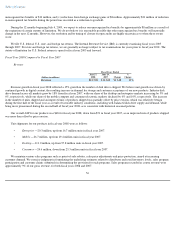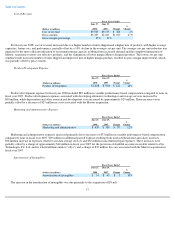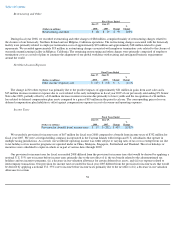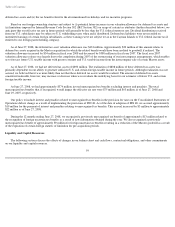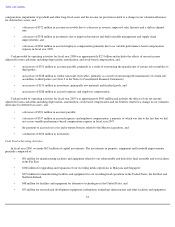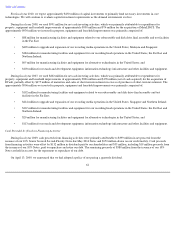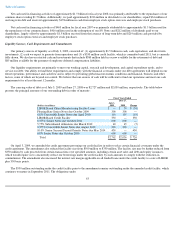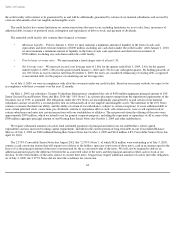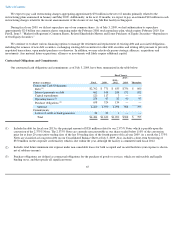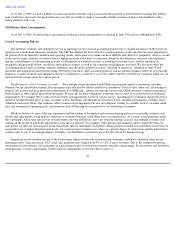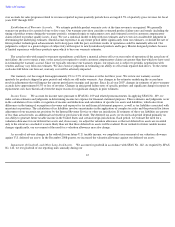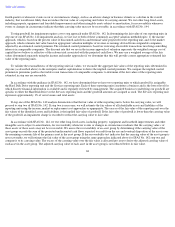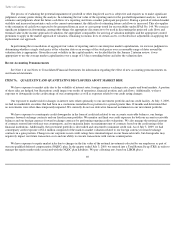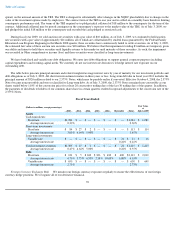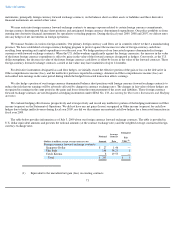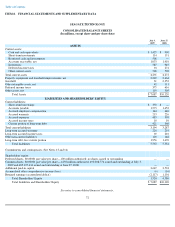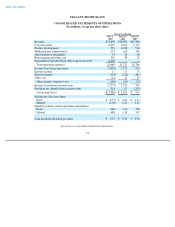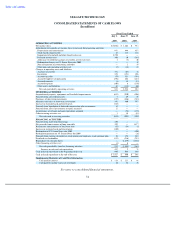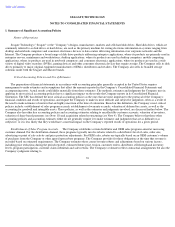Seagate 2008 Annual Report Download - page 68
Download and view the complete annual report
Please find page 68 of the 2008 Seagate annual report below. You can navigate through the pages in the report by either clicking on the pages listed below, or by using the keyword search tool below to find specific information within the annual report.
Table of Contents
As of July 3, 2009, we had a liability for unrecognized tax benefits and an accrual for the payment of related interest totaling $69 million,
none of which is expected to be paid within one year. We are unable to make a reasonably reliable estimate of when cash settlement with a
taxing authority will occur.
Off-Balance Sheet Arrangements
As of July 3, 2009, we did not have any material off-balance sheet arrangements (as defined in Item 303(a)(4)(ii) of Regulation S-K).
Critical Accounting Policies
The methods, estimates and judgments we use in applying our most critical accounting policies have a significant impact on the results we
report in our consolidated financial statements. The SEC has defined the most critical accounting policies as the ones that are most important to
the portrayal of our financial condition and operating results, and require us to make our most difficult and subjective judgments, often as a result
of the need to make estimates of matters that are highly uncertain at the time of estimation. Based on this definition, our most critical policies
include: establishment of sales program accruals, establishment of warranty accruals, accounting for income taxes, and the valuation of
intangibles and goodwill. Below, we discuss these policies further, as well as the estimates and judgments involved. We also have other key
accounting policies and accounting estimates relating to uncollectible customer accounts, valuation of inventory, valuation of share-based
payments and acquisition related restructuring. We believe that these other accounting policies and accounting estimates either do not generally
require us to make estimates and judgments that are as difficult or as subjective, or it is less likely that they would have a material impact on our
reported results of operations for a given period.
Establishment of Sales Program Accruals. We establish certain distributor and OEM sales programs aimed at increasing customer
demand. For the distribution channel, these programs typically involve rebates related to a distributor's level of sales, order size, advertising or
point of sale activity and price protection adjustments. For OEM sales, rebates are typically based on an OEM customer's volume of purchases
from Seagate or other agreed upon rebate programs. We provide for these obligations at the time that revenue is recorded based on estimated
requirements. We estimate these contra-revenue rebates and adjustments based on various factors, including price reductions during the period
reported, estimated future price erosion, customer orders, distributor sell-through and inventory levels, program participation, customer claim
submittals and sales returns. Our estimates reflect contractual arrangements but also our judgment relating to variables such as customer claim
rates and attainment of program goals, and inventory and sell-through levels reported by our distribution customers.
While we believe we have sufficient experience and knowledge of the market and customer buying patterns to reasonably estimate such
rebates and adjustments, actual market conditions or customer behavior could differ from our expectations. As a result, actual payments under
these programs, which may spread over several months after the related sale, may vary from the amount accrued. Accordingly, revenues and
margins in the period in which the adjustment occurs may be affected. For example, if the pricing environment is more competitive than we
anticipated, accruals for forward price protection rebates may be inadequate. In addition, during periods in which our distributors' inventories of
our products are at higher than historical levels, our contra-revenue estimates are subject to a greater degree of subjectivity and the potential for
actual results to vary is accordingly higher. Currently, our distributors' inventories are at the low end of the historical range.
Significant actual variations in any of the factors upon which we base our contra-revenue estimates could have a material effect on our
operating results. Since fiscal year 2007, total sales programs have ranged from 9% to 12% of gross revenues. Due to the competitive pricing
environment in our industry, sales programs as a percentage of gross revenue may increase from the current range. If such rebates and incentives
trend upwards, revenues and margins will be reduced. Adjustments to revenues due to under or
66


